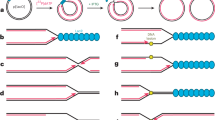Abstract
THE discovery of catalytically active RNA has provided the basis for the evolutionary concept of an RNA world. It has been proposed that during evolution the functions of ancient catalytic RNA were modulated by low molecular weight effectors, related to antibiotics, present in the primordial soup. Antibiotics and RNA may have coevolved in the formation of the modern ribosome1. Here we report that a set of aminoglycoside antibiotics, which are known to interact with the decoding region of the 16S ribosomal RNA of Escherichia coli2–4, inhibit the second step of splicing of the T4 phage-derived td intron. Thus catalytic RNA seems to interact not only with a mononucleotide5 and an amino acid6, but also with another class of biomolecules, the sugars. Splicing of other group I introns but not group II introns was inhibited. The similarity in affinity and specificity of these antibiotics for group I introns and rRNAs may result from recognition of evolutionarily conserved structures.
This is a preview of subscription content, access via your institution
Access options
Subscribe to this journal
Receive 51 print issues and online access
$199.00 per year
only $3.90 per issue
Buy this article
- Purchase on Springer Link
- Instant access to full article PDF
Prices may be subject to local taxes which are calculated during checkout
Similar content being viewed by others
References
Davies, J. Molec. Microbiol. 4, 1227–1232 (1990).
Moazed, D. & Noller, H. F. Nature 327, 389–394 (1987).
Noller, H. F. A. Rev. Biochem. 53, 119–162 (1984).
Cundliffe, E. in The Ribosome (eds Hill, W. E. et al.) 479–490 (Am. Soc. Microbiol., Washington 1990).
Bass, B. & Cech, T. R. Biochemistry 25, 4473–4477 (1986).
Yarus, M. Science 240, 1751–1758 (1988).
Cech, T. R. A Rev. Biochem. 59, 543–568 (1990).
Schroeder, R., von Ahsen, U. & Belfort, M. Biochemistry 30, 3295–3303 (1991).
Ehrenman, K. et al. Proc. natn. Acad. Sci. USA 83, 5875–5879 (1986).
Michel, F., Hanna, M., Green, R., Bartel, D. P. & Szostak, J. W. Nature 342, 391–395 (1989).
Burke, J. M., Esherik, J. S., Burfeind, W. R. & King, J. Nature 344, 80–82 (1990).
Michel, F. & Westhof, E. J. molec. Biol. 216, 585–610 (1990).
Ahsen von, U. & Schroeder, R. Nucleic Acids Res. 19, 2261–2265 (1991).
Ahsen von, U. & Schroeder, R. Nature 346, 801 (1990).
Benveniste, R. & Davies, J. Antimicrob. Agents Chemother. 4, 402–409 (1973).
Yarus, M. & Christian, E. L. Nature 342, 349–350 (1990).
Akins, R. & Lambowitz, A. Cell 50, 331–345 (1987).
Herbert, C. Labouesse, M., Dujardin, G. & Slonimski, P. P. EMBO J. 7, 473–483 (1988).
Seraphin, B. Simon, M., Boulet, A. & Faye, G. Nature 337, 84–87 (1989).
Gale, E. F. in Biochemical Studies of Antimicrobial Drugs (eds Newton, B. A. & Reynolds, P. E.) 1–21 (Cambridge University Press, Cambridge, 1966).
Salvo, J. L. G., Coetzee, T. & Belfort, M. J. molec. Biol. 211, 537–549 (1990).
Michel, F., Netter, P., Xu, M.-Q. & Shub, D. Genes Dev. 4, 777–788 (1990).
Davies, J. & Yagisawa, M. in Biochemistry and Genetic Regulation of Commercially Important Antibiotics (ed. Vining, L. C.) 329–354 (Addison-Wesley, London, 1983).
Author information
Authors and Affiliations
Rights and permissions
About this article
Cite this article
von Ahsen, U., Davies, J. & Schroeder, R. Antibiotic inhibition of group I ribozyme function. Nature 353, 368–370 (1991). https://doi.org/10.1038/353368a0
Received:
Accepted:
Issue Date:
DOI: https://doi.org/10.1038/353368a0
This article is cited by
-
Genome-wide identification of Kanamycin B binding RNA in Escherichia coli
BMC Genomics (2023)
-
Inhibition of RNA-binding proteins with small molecules
Nature Reviews Chemistry (2020)
-
Small molecules that target group II introns are potent antifungal agents
Nature Chemical Biology (2018)
-
Antibiotics and evolution: food for thought
Journal of Industrial Microbiology and Biotechnology (2016)
-
Rapid RNA–ligand interaction analysis through high-information content conformational and stability landscapes
Nature Communications (2015)
Comments
By submitting a comment you agree to abide by our Terms and Community Guidelines. If you find something abusive or that does not comply with our terms or guidelines please flag it as inappropriate.



